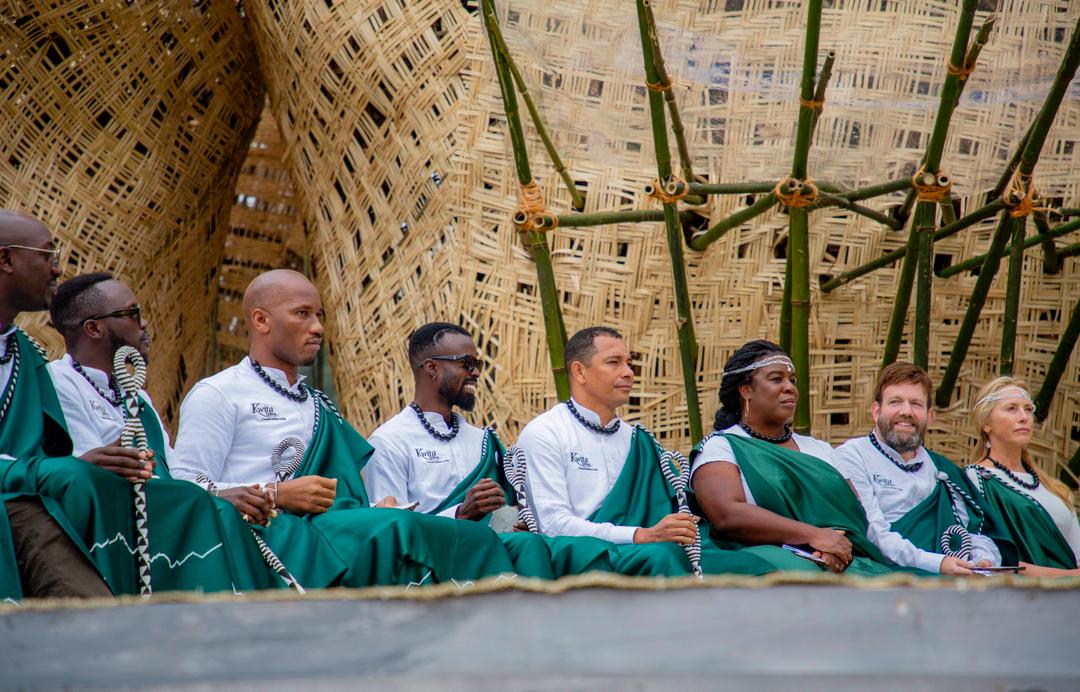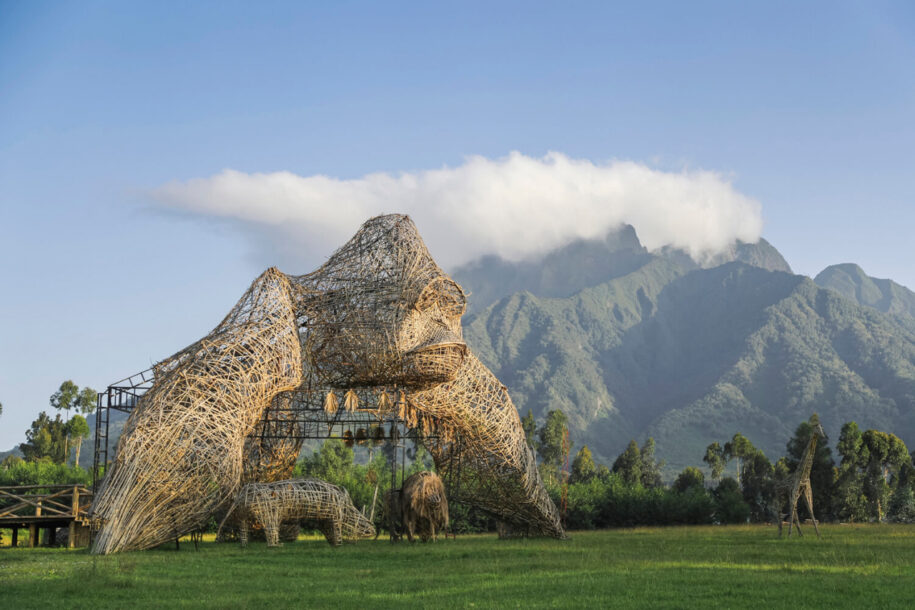Each year in Rwanda, Kwita Izina brings international conservationists, government officials, scientists, and invited guests together for one purpose: to name infant mountain gorillas. This event takes place near Volcanoes National Park, where the majority of Rwanda’s mountain gorillas live under strict protection.
The ceremony draws on a long-standing cultural tradition which is naming newborns in front of the community. Rwanda adapted this practice in 2005 to highlight the role of mountain gorillas in ecological and economic development.
Since then, Kwita Izina has evolved into a structured platform for conservation awareness, scientific engagement, and policy alignment. It further showcases Rwanda’s conservation strategy and the integration of tourism with environmental management.
The Origins of Kwita Izina
The foundation of Kwita Izina lies in a Rwandan custom of public naming of a newborn, held with family and community present.
Historically, this practice marked a child’s formal acceptance into society. It established a bond between the individual and their wider community.
In 2005, Rwanda adapted this custom for a different purpose, to draw attention to the country’s conservation efforts, particularly those focused on endangered mountain gorillas.
Mountain gorillas live only in a small section of the Virunga Massif, which includes parts of Rwanda, Uganda, and the Democratic Republic of Congo.
By the early 2000s, gorilla populations faced serious pressure from poaching, habitat loss, and political instability in the region.
Rwanda’s leadership recognised that protecting gorillas required more than legislation. It also needed visible commitment, local involvement, and international engagement.
Kwita Izina became a symbolic gesture rooted in culture but aligned with science and policy. It emphasised the gorillas’ value and the human responsibility to protect them.
This adaptation of a local tradition gave the ceremony both legitimacy and meaning. It connected modern conservation goals to familiar social practices, which helped build local support.
How the Ceremony Works
The Kwita Izina ceremony takes place towards the end of the year near the town of Kinigi, adjacent to Volcanoes National Park in Rwanda’s Northern Province.
Rwanda Development Board (RDB) manages the event, working with park staff, conservation partners, and local authorities to organise each year’s program.
Only newborn mountain gorillas from the previous 12 months receive names. All births are recorded by park rangers and tracked as part of ongoing monitoring efforts.
The naming process does not happen casually. Selected individuals — including conservationists, scientists, national figures, and guests — formally name each infant gorilla on stage.
These names carry meaning. Each reflects a quality, hope, or observed behaviour linked to the gorilla or its group. The names are given in Kinyarwanda.
Before the ceremony, community groups, schools, and park stakeholders hold educational events and discussions. These activities reinforce the link between gorilla protection and local livelihoods.

On the day of the event, performances, speeches, and cultural presentations create a structured atmosphere. However, conservation remains the central focus throughout the program.
Media coverage is extensive. Regional broadcasters and international outlets report on the event, highlighting both the gorilla births and Rwanda’s conservation model.
While the audience includes guests, the broader aim is visibility and to show how naming individual gorillas reinforces their protection and personhood within the national narrative.
Conservation Impact of Kwita Izina
Kwita Izina plays a direct role in raising both awareness and funding for mountain gorilla conservation in Rwanda. This impact is measurable and significant.
Population Recovery Through Long-Term Monitoring
Since Kwita Izina began in 2005, mountain gorilla numbers in the Virunga Massif have grown. Intensive monitoring and regulated tourism contributed to this trend.
Each gorilla birth is documented by trackers and researchers working daily in the forest. These data inform conservation decisions and track group dynamics over time.
By assigning names, the ceremony transforms gorillas from biological data points into individual lives. This changes how people, especially locals, relate to the animals.
Revenue Generation for Protection and Development
Rwanda applies a revenue-sharing model for park income. A percentage of tourism proceeds goes to local projects, including schools, health centres, and water systems.
This direct financial benefit builds trust between conservation authorities and nearby communities. It reduces resistance to wildlife protection and discourages activities like illegal grazing or poaching.
Additionally, the naming ceremony itself generates income. It increases demand for local services like catering, transport, and performance groups tied to the event.
Education and Community Awareness
Leading up to the ceremony, the Rwanda Development Board supports workshops and school programs. These sessions cover conservation science, park policies, and gorilla behaviour.
By linking local knowledge to broader environmental goals, these programs strengthen support for the park and its management policies.
The ceremony also functions as a communication platform. It reinforces consistent messaging around wildlife protection, especially for younger generations.
Cultural Significance as a Conservation Tool
Giving gorillas names using Kinyarwanda affirms their place in the national story. It creates cultural ownership and makes conservation a matter of identity.
This cultural alignment strengthens local participation. It reduces the sense of exclusion that can occur when protected areas restrict access to ancestral lands.
Global Partnerships and Conservation Diplomacy
Kwita Izina also serves as a convening moment for conservation diplomacy. International organisations use the platform to share research and build regional cooperation.
Cross-border initiatives between Rwanda, Uganda, and the DRC often gain visibility during the event. These efforts are crucial for managing a species that ignores political boundaries.
Global Recognition and Participation
Kwita Izina has become one of the most visible conservation events on the continent, drawing international attention from media, policymakers, and environmental organisations.
Its guest list includes representatives from UNESCO, IUCN, World Wildlife Fund, and other institutions focused on biodiversity protection and sustainable tourism development.
Each year, guests from abroad take part in the naming process. These include scientists, diplomats, entrepreneurs, and leaders of conservation-focused foundations.
This global participation helps frame gorilla conservation not as a local issue, but as part of a broader ecological and developmental agenda.
High-profile attendance also increases media coverage. The event often receives international press, which boosts visibility for Rwanda’s conservation strategy and reinforces its global partnerships.
However, the ceremony remains rooted in Rwandan leadership. Local conservation professionals and national officials take active roles in shaping each year’s theme and messaging.
The Rwanda Development Board plays a central role in organising and promoting the event. Its involvement ensures alignment between tourism policy and conservation practice.
International collaboration does not dilute local ownership. Instead, it strengthens it by providing additional resources and reinforcing Rwanda’s position in global conservation dialogues.
Through Kwita Izina, Rwanda has positioned itself as a credible actor in nature-based tourism and species protection. The ceremony continues to shape that narrative year after year.
A Symbol of Rwanda’s Conservation Model
Kwita Izina reflects a broader strategy that links conservation, tourism, and community involvement into one unified model.
Rwanda approaches conservation through integration. Protected areas are not isolated. They are part of national development goals, tied to local economies and regional partnerships.
Local communities near Volcanoes National Park receive a share of park tourism revenue. This revenue-sharing model provides direct incentives to support gorilla protection.
Community projects, from schools to clean water access, demonstrate how conservation delivers measurable benefits to nearby populations. This builds long-term support and reduces conflict with wildlife.

Rwanda also invests heavily in park infrastructure and ranger training. These operational investments help maintain strict monitoring of gorilla families and prevent illegal activity.
At the policy level, Rwanda aligns its tourism laws with conservation outcomes. The number of visitors allowed to track gorillas remains limited and closely controlled.
This balance between access and protection reinforces the idea that conservation works when it is structured, funded, and enforced.
Kwita Izina gives this model public visibility. It shows how formal institutions, scientific data, and cultural traditions can work together to protect a species and strengthen a nation’s identity.
By keeping the ceremony consistent yet adaptive, Rwanda has created a conservation event that is both symbolic and practical, a rare combination in the global tourism space.
What Kwita Izina Teaches Us About Conservation
Public ceremonies rarely affect wildlife policy. Most operate in the background, separate from community life and public engagement. Kwita Izina challenges that norm.
It shows that conservation can occupy a national stage without losing credibility or becoming symbolic theatre. Ceremony and substance, often treated as opposites, are fully aligned here.
By elevating each gorilla birth to a matter of national interest, Rwanda redefines how wildlife conservation is perceived. It becomes civic, visible, and shared.
That shift matters. It builds emotional and political space for long-term environmental planning. It helps conservation move beyond expert circles and into national consciousness.
Kwita Izina is not just a model. It is a reminder that visibility, when rooted in clarity and purpose, can drive systems change in conservation practice.


Leave a Reply
You must be logged in to post a comment.